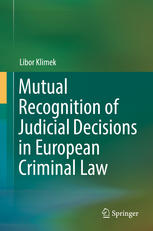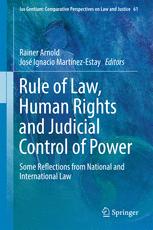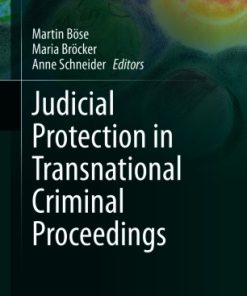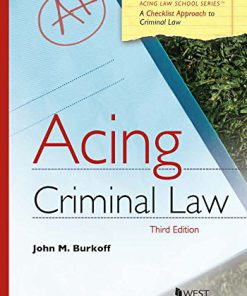Mutual Recognition of Judicial Decisions in European Criminal Law 1st Edition by Libor Klimek 9783319443751 3319443755
$50.00 Original price was: $50.00.$25.00Current price is: $25.00.
Mutual Recognition of Judicial Decisions in European Criminal Law 1st Edition by Libor Klimek – Ebook PDF Instant Download/Delivery:9783319443751,3319443755
Full download Mutual Recognition of Judicial Decisions in European Criminal Law 1st Edition after payment

Product details:
ISBN 10:3319443755
ISBN 13:9783319443751
Author:Libor Klimek
This book examines the mutual recognition of judicial decisions in European criminal law as a cornerstone of judicial co-operation in criminal matters in the European Union. Providing comprehensive content and combining theoretical and practical aspects, it covers all of the major issues surrounding mutual recognition. The book analyses its definition, genesis, principles, case law, implementation and evaluation. Special attention is given to mutual recognition measures, namely European arrest warrant (i.e. surrender procedure), mutual recognition of custodial sentences, and measures involving deprivation of liberty, mutual recognition of probation measures and alternative sanctions, mutual recognition of financial penalties, mutual recognition of confiscation orders, the European supervision order in pre-trial procedures (i.e. mutual recognition of supervision measures as an alternative to provisional detention), the European investigation order (i.e. free movement of evidence), and the European protection order (i.e. mutual recognition of protection orders). Instead of focusing solely on a criminal law approach, the book also considers the subject from the perspectives of European Union law and International criminal law.
Mutual Recognition of Judicial Decisions in European Criminal Law 1st Table of contents:
Part I: Introduction to Mutual Recognition in Criminal Matters
Chapter 1: Definition of Mutual Recognition in Criminal Matters
1.1 Mutual Recognition as a General Concept of the European Union
1.2 Mutual Recognition in Criminal Matters as a Part of the Judicial Co-operation in the European Un
1.3 Mutual Recognition in Criminal Matters in European Union Primary Law
1.4 Mutual Recognition in Criminal Matters in European Union Secondary Law
1.4.1 Introduction
1.4.2 Framework Decisions (2002-2009)
1.4.2.1 Nature
1.4.2.2 Why Mutual Recognition in Criminal Matters Was Originally Introduced by Framework Decisions?
1.4.2.3 Obligation to Interpret National Legislation in Conformity with Framework Decisions: The Cou
1.4.2.4 Compatibility of Framework Decisions: The Court of Justice of the European Union Case of Adv
1.4.3 Directives (Since 2010)
1.4.4 Concrete Mutual Recognition Legislative Instruments
1.4.5 Obligation to Implement the Mutual Recognition Legislative Instruments into National Law of th
1.5 Scope of Mutual Recognition in Criminal Matters
1.6 Grounds for Non-recognition or Non-execution the Decision as Derogation of Mutual Recognition in
1.7 Concluding Observations
References
Chapter 2: Genesis
2.1 Modern European Integration in the Area of European Union
2.2 Mutual Assistance as Predecessor of the Mutual Recognition in Criminal Matters in the European U
2.3 Early Ideas of the Mutual Recognition in Criminal Matters: The Council of Europe Conventions
2.4 Treaty on European Union: Enhanced Co-operation in Criminal Matters in the European Union
2.4.1 Third Pillar of the European Union
2.4.2 Area of Freedom, Security and Justice in the European Union
2.5 Evolution of the Mutual Recognition in Criminal Matters in the European Union: Concrete Steps
2.5.1 Cardiff European Council (1998): Introducing the Mutual Recognition in Criminal Matters
2.5.2 Vienna Action Plan (1998): Facilitating the Mutual Recognition in Criminal Matters
2.5.3 Tampere European Council (1999): Mutual Recognition as the Cornerstone of Judicial Co-operatio
2.5.4 Communication of the European Commission on Mutual Recognition of Final Decisions in Criminal
2.5.5 Programme of Measures to Implement the Principle of Mutual Recognition of Decisions in Crimina
2.5.6 European Arrest Warrant (2002): The First Mutual Recognition Measure in Criminal Matters
2.5.7 Mutual Recognition of Disqualifications Arising from a Criminal Proceedings (2002): Unsuccessf
2.5.8 Acceptance of the Mutual Recognition in Criminal Matters as an Obligation and Acceptance of th
2.5.9 Order Freezing Property or Evidence (2003): The Second Mutual Recognition Measure in Criminal
2.5.10 Green Paper on Mutual Recognition in Criminal Matters (2004): An Incomplete Range of Mutual R
2.5.11 `Unsuccessful´ Treaty Establishing a Constitution for Europe (2004): Mutual Recognition as B
2.5.12 `Unsuccessful´ Mutual Recognition of Prohibitions Arising from Convictions for Sexual Offenc
2.5.13 Mutual Recognition of Financial Penalties (2005): The Third Mutual Recognition Measure in Cri
2.5.14 The Hague Programme (2005): Further Efforts to Facilitate the Mutual Recognition in Criminal
2.5.15 Mutual Recognition of Confiscation Orders (2006): The Fourth Mutual Recognition Measure in Cr
2.5.16 Mutual Recognition of Custodial Sentences and Measures Involving Deprivation of Liberty (2008
2.5.17 Mutual Recognition of Probation Measures and Alternative Sanctions (2008): The Sixth Mutual R
2.5.18 European Evidence Warrant (2008): The Seventh Mutual Recognition Measure in Criminal Matters
2.5.19 European Supervision Order in Pre-trial Procedures (2009): The Eight Mutual Recognition Measu
2.5.20 Amendment of Several Measures (2009)
2.5.21 Mutual Recognition in Criminal Matters as a General Objective (2009-Present): The Treaty on E
2.5.22 Stockholm Programme (2009): Confirmation of the Mutual Recognition and Mutual Trust and Their
2.5.23 European Protection Order (2011): The Ninth Mutual Recognition Measure in Criminal Matters
2.5.24 European Investigation Order (2014): The Tenth Mutual Recognition Measure in Criminal Matters
2.6 Concluding Observations
References
Chapter 3: Methodology
3.1 Problem Description
3.2 Review of Research Literary Sources
3.3 Objectives
3.4 Hypothesis
3.5 Research Methods
3.6 Data Gathering Methods
3.7 Possible Problems
3.8 Preliminary Work
3.9 Structure
Chapter 4: Principles of Mutual Recognition Measures
4.1 Introduction
4.2 Mutual Recognition of Judicial Decisions
4.2.1 A Brief Overview
4.2.2 Enactment in the Mutual Recognition Legislative Instruments
4.3 Mutual Trust Between Member States of the European Union
4.3.1 General Overview
4.3.2 Enactment in the Mutual Recognition Legislative Instruments
4.3.3 Enactment in the Other Legislative Instruments
4.3.4 Challenging the Mutual Trust
4.4 Direct Communication Between National Authorities of the Member States
4.4.1 General Overview
4.4.2 Enactment in the Mutual Recognition Legislative Instruments
4.5 Partial Removal of the Double Criminality Requirement
4.5.1 General Overview
4.5.2 Enactment in the Mutual Recognition Legislative Instruments
4.6 Removal of the Rule of Reciprocity
4.7 The Rule of Speciality
4.8 Conforming Interpretation of National Laws on Mutual Recognition with European Union Law
4.8.1 General Overview
4.8.2 Enactment in the Mutual Recognition Legislative Instruments
4.9 Concluding Observations
References
Part II: Mutual Recognition Measures
Chapter 5: European Arrest Warrant (Surrender Procedure)
5.1 Introduction
5.1.1 First Introduction of the European Arrest Warrant in the Corpus Juris Project and Its Failure
5.1.2 Tampere European Council: Replacement of Extradition Procedure in the European Union
5.1.3 9/11 Plane Attacks in the United States of America
5.1.4 Negotiating and Adopting the Legislation on the European Arrest Warrant
5.2 Legal Basis: The Framework Decision 2002/584/JHA on the European Arrest Warrant
5.2.1 Objective
5.2.2 Related Legislation
5.2.3 Framework Decision Compatibility: The Court of Justice of the European Union Case of Advocaten
5.2.4 Constitutional Pressures
5.2.4.1 Poland: Revision of the Constitution
5.2.4.2 Germany: `Double Implementation´ of the Framework Decision 2002/584/JHA on the European Arr
5.2.4.3 Czech Republic: `EU-Friendly´ Interpretation of the Constitution
5.2.4.4 Cyprus: Revision of the Constitution
5.2.5 Framework Decision Amendment
5.3 Definition, Scope of Application of Application
5.3.1 Definition and Main Features
5.3.2 European Arrest Warrant and Fundamental Rights
5.4 Procedures
5.4.1 Principles
5.4.1.1 Mutual Recognition of Judicial Decisions
5.4.1.2 Mutual Trust Between Member States of the European Union
5.4.1.3 Direct Communication Between National Authorities of the Member States
5.4.1.4 Partial Removal of the Double Criminality Requirement
5.4.1.5 Removal of the Rule of Reciprocity
5.4.1.6 The Rule of Speciality
5.4.1.7 Execution the European Arrest Warrant in Line with the Framework Decision 2002/584/JHA on th
5.4.2 Issuing the European Arrest Warrant
5.4.2.1 Alternatives of Issuing
`Standard´ Issuing
Issuing Without Verification of the Double Criminality of the Offence
5.4.2.2 Proportionality Test
5.4.2.3 Form and Content
5.4.2.4 Transmission
5.4.2.5 Language
5.4.3 Execution the European Arrest Warrant
5.4.3.1 Obligation to Execute the European Arrest Warrant
5.4.3.2 Decision on Surrender in the Event of Multiple Requests
5.4.3.3 Consent to Surrender
5.4.3.4 Time Limits
5.4.3.5 Grounds for Non-execution
Mandatory Non-execution
Optional Non-execution
5.4.3.6 Pre-surrender Detention
5.4.3.7 Transit of a Requested Person and Expenses
5.4.3.8 Handing Over of Property
5.4.3.9 Execution of the Retroactively Issued European Arrest Warrants
5.4.3.10 Procedural Safeguards (Guarantees and Rights)
Right To Be Informed of the European Arrest Warrant and of Its Contents
Right to a Letter of Rights
Right To Be Assisted by a Legal Counsel
Right To Be Assisted by an Interpreter
Right to Translation
Right to Consent to Surrender
Right To Be Heard by the Executing Judicial Authority
Right to Demand the Rule of Speciality
Right of Appeal Against Decisions Relating to European Arrest Warrant
5.4.4 Surrender Procedure and Nordic Countries (Norway and Island)
5.4.5 `Surrender´ vs. `Extradition´: A Comparison Focused on Innovations of the European Arrest Wa
5.4.5.1 Terminology and Material Act: `Surrender´ vs. `Extradition´
5.4.5.2 Legal Basis: EU´s Framework Decision vs. International Convention(s)
5.4.5.3 The Obligation to Execute the Request: Mutual Recognition vs. Assistance
5.4.5.4 Nature of Procedure: Judicial vs. Political
5.4.5.5 The Requested Person´s Nationality: EU Citizens vs. EU Member States Nationals
5.4.5.6 Double Criminality: Softening vs. Mandatory Requirement
5.4.5.7 Time Limits: Matter of Urgency vs. Months or Years
5.4.5.8 Grounds for Non-execution the Request: Limited vs. `Unlimited´
5.5 Implementation
5.5.1 Deadline for Implementation
5.5.2 Degree and Method of Implementation in the Member States
5.5.3 Special Issues
5.5.3.1 Definition of the Term `European Arrest Warrant´
5.5.3.2 Scope of Application
5.5.3.3 Content and Form of the European Arrest Warrant
5.5.3.4 Time Limits
5.5.3.5 Grounds for Non-execution the European Arrest Warrant
5.6 Evaluation
5.6.1 Evaluations by the European Commission
5.6.2 Evaluations by the Council of the European Union and Its Recommendations
5.6.3 Doctrinal Assessments
5.7 Concluding Observations
References
Chapter 6: Mutual Recognition of Custodial Sentences and Measures Involving Deprivation of Liberty
6.1 Introduction
6.2 Legal Basis: The Framework Decision 2008/909/JHA on the Mutual Recognition of Custodial Sentence
6.2.1 Objective
6.2.2 Related Legislation
6.2.3 Framework Decision Amendment
6.3 Definition, Scope of Application and Key Terms
6.4 Procedures
6.4.1 Principles
6.4.1.1 Mutual Recognition of Judicial Decisions
6.4.1.2 Mutual Trust Between Member States of the European Union
6.4.1.3 Direct Communication Between National Authorities of the Member States
6.4.1.4 Partial Removal of the Double Criminality Requirement
6.4.1.5 The Rule of Speciality
6.4.2 Transmission of a Decision on Custodial Sentence or Measure Involving Deprivation of Liberty t
6.4.2.1 Transmission of a Decision and Its Certificate
6.4.2.2 Languages
6.4.3 Recognition and Execution of a Decision on Custodial Sentence or Measure Involving Deprivation
6.4.3.1 Recognition of a Decision
6.4.3.2 Execution of a Decision
6.4.3.3 Enforcement of Sentences Following the European Arrest Warrant
6.4.3.4 Grounds for Non-recognition and Non-enforcement a Decision
6.4.3.5 Transfer of Sentenced Persons
6.5 Implementation
6.5.1 Obligation to Implement the Framework Decision 2008/909/JHA on the Mutual Recognition of Custo
6.5.2 Degree and Method of Implementation in the Member States
6.5.3 Special Issues
6.6 Evaluation
6.7 Concluding Observations
References
Chapter 7: Mutual Recognition of Probation Measures and Alternative Sanctions
7.1 Introduction
7.2 Legal Basis: The Framework Decision 2008/947/JHA on Mutual Recognition of Probation Measures and
7.2.1 Objective
7.2.2 Related Legislation
7.2.3 Framework Decision Amendment
7.3 Definition, Scope of Application and Key Terms
7.4 Procedures
7.4.1 Principles
7.4.1.1 Mutual Recognition of Judicial Decisions
7.4.1.2 Mutual Trust Between Member States of the European Union
7.4.1.3 Direct Communication Between National Authorities of the Member States
7.4.1.4 Partial Removal of the Double Criminality Requirement
7.4.2 Transmission of a Decision to the Other State
7.4.2.1 Transmission of a Decision and Its Certificate
7.4.2.2 Languages
7.4.2.3 Consequences of Transmission of a Decision and Its Certificate
7.4.3 Recognition and Execution of a Decision in the Executing State
7.4.3.1 Recognition of a Decision
7.4.3.2 Adaptation of the Supervision Measures
7.4.3.3 Execution of a Decision
7.4.3.4 Jurisdiction of the Executing State
7.4.3.5 Grounds for Non-recognition and Non-supervision a Decision
7.4.3.6 Further Communication Between Issuing and Executing State
7.5 Implementation
7.5.1 Obligation to Implement the Framework Decision 2008/947/JHA on Mutual Recognition of Probation
7.5.2 Degree and Method of Implementation in the Member States
7.6 Evaluation
7.7 Concluding Observations
References
Chapter 8: Mutual Recognition of Financial Penalties
8.1 Introduction
8.2 Legal Basis: The Framework Decision 2005/214/JHA on the Mutual Recognition of Financial Penaltie
8.2.1 Objective
8.2.2 Related Legislation
8.2.3 Framework Decision Amendment
8.3 Definition, Scope of Application and Key Terms
8.4 Procedures
8.4.1 Principles
8.4.1.1 Mutual Recognition of Judicial Decisions
8.4.1.2 Mutual Trust Between Member States of the European Union
8.4.1.3 Direct Communication Between National Authorities of the Member States
8.4.1.4 Partial Removal of the Double Criminality Requirement
8.4.2 Transmission of a Decision on Financial Penalty to the Other State
8.4.2.1 Transmission of a Decision and Its Certificate
8.4.2.2 Languages
8.4.2.3 Consequences of Transmission of a Decision and Its Certificate
8.4.3 Recognition and Execution of a Decision on Financial Penalty in the Executing State
8.4.3.1 Recognition of a Decision
8.4.3.2 Execution of a Decision
8.4.3.3 Impossibility to Enforce a Decision
8.4.3.4 Grounds for Non-recognition and Non-execution a Decision
8.4.3.5 Further Communication Between Issuing and Executing State
8.4.4 Accrual of Monies Obtained from Enforcement of Decisions
8.5 Implementation
8.5.1 Obligation to Implement the Framework Decision 2005/214/JHA on the Mutual Recognition of Finan
8.5.2 Degree and Method of Implementation in the Member States
8.6 Evaluation
8.7 Concluding Observations
References
Chapter 9: Mutual Recognition of Confiscation Orders
9.1 Introduction
9.2 Legal Basis: The Framework Decision 2006/783/JHA on the Mutual Recognition of Confiscation Order
9.2.1 Objective
9.2.2 Related Legislation
9.2.3 Framework Decision Amendment
9.3 Definition, Scope of Application and Key Terms
9.4 Procedures
9.4.1 Principles
9.4.1.1 Mutual Recognition of Judicial Decisions
9.4.1.2 Mutual Trust Between Member States of the European Union
9.4.1.3 Direct Communication Between National Authorities of the Member States
9.4.1.4 Partial Removal of the Double Criminality Requirement
9.4.2 Transmission of a Confiscation Order
9.4.2.1 Transmission of a Decision and Its Certificate
9.4.2.2 Languages
9.4.2.3 Consequences of Transmission of a Confiscation Order
9.4.3 Recognition and Execution of a Confiscation Order in the Executing State
9.4.3.1 Recognition of a Decision
9.4.3.2 Execution of a Decision
9.4.3.3 Grounds for Non-recognition and Non-execution a Decision
9.4.3.4 Further Communication Between Issuing and Executing State
9.4.4 Disposal of Confiscated Property
9.5 Implementation
9.5.1 Obligation to Implement the Framework Decision 2006/783/JHA on the Mutual Recognition of Confi
9.5.2 Degree and Method of Implementation in the Member States
9.5.3 Special Issues
9.6 Concluding Observations
References
Chapter 10: European Supervision Order in Pre-trial Procedures (Mutual Recognition of Supervision Me
10.1 Introduction
10.2 Legal Basis: The Framework Decision 2009/829/JHA on the European Supervision Order
10.2.1 Objectives
10.2.2 Related Legislation
10.3 Definition, Scope of Application and Key Terms
10.4 Procedures
10.4.1 Principles
10.4.1.1 Mutual Recognition of Judicial Decisions
10.4.1.2 Mutual Trust Between Member States of the European Union
10.4.1.3 Direct Communication Between National Authorities of the Member States
10.4.1.4 Partial Removal of the Double Criminality Requirement
10.4.2 Transmission of a Decision on Supervision Measures to the Other State
10.4.2.1 Transmission of a Decision and Its Certificate
10.4.2.2 Language
10.4.2.3 Competence of the Issuing State to Take All Subsequent Decisions
10.4.3 Recognition and Execution of a Decision on Supervision Measures in the Executing State
10.4.3.1 Recognition of a Decision
10.4.3.2 Adaptation of the Supervision Measures
10.4.3.3 Execution of a Decision
10.4.3.4 Grounds for Non-recognition a Decision
10.4.4 Monitoring of the Supervision Measures
10.5 Implementation
10.5.1 Obligation to Implement the Framework Decision 2009/829/JHA on the European Supervision Order
10.5.2 Special Issues
10.6 Evaluation
10.7 Concluding Observations
References
Chapter 11: European Investigation Order (Free Movement of Evidence)
11.1 Introduction
11.2 Legal Basis: The Directive 2014/41/EU on the European Investigation Order
11.2.1 Objective
11.2.2 Related Legislation
11.3 Definition, Scope of Application and Key Terms
11.4 Procedures
11.4.1 Principles
11.4.1.1 Mutual Recognition of Judicial Decisions
11.4.1.2 Mutual Trust Between Member States of the European Union
11.4.1.3 Direct Communication Between National Authorities of the Member States
11.4.1.4 Partial Removal of the Double Criminality Requirement
11.4.2 Issuing and Transmission of a European Investigation Order to the Other State
11.4.2.1 Issuing
11.4.2.2 Transmission
11.4.2.3 Languages
11.4.3 Recognition and Execution of a European Investigation Order
11.4.3.1 Recognition
11.4.3.2 Execution
11.4.3.3 Transfer of Evidence
11.4.3.4 Recourse to a Different Type of Investigative Measure
11.4.3.5 Grounds for Non-recognition and Non-execution a Decision
11.4.3.6 Further Communication Between Issuing and Executing State
11.4.4 Specific Rules for Hearing
11.5 Implementation
11.6 Concluding Observations
References
Chapter 12: European Protection Order (Mutual Recognition of Protection Orders)
12.1 Introduction
12.2 Legal Basis: The Directive 2011/99/EU on the European Protection Order
12.2.1 Objective
12.2.2 Related Legislation
12.3 Definition, Scope of Application and Key Terms
12.3.1 `European Protection Order in Criminal Matters´
12.3.2 `European Protection Order in Criminal Matters´ Versus `European Protection Order in Civil M
12.4 Procedures
12.4.1 Principles
12.4.1.1 Mutual Recognition of Judicial Decisions
12.4.1.2 Mutual Trust Between Member States of the European Union
12.4.1.3 Direct Communication Between National Authorities of the Member States
12.4.2 Issuing the European Protection Order
12.4.2.1 Conditions and Request for the Issuing
12.4.2.2 Form and Content
12.4.2.3 Transmission
12.4.2.4 Languages
12.4.2.5 Competence in the Issuing State
12.4.3 Recognition and Execution of the European Protection Order
12.4.3.1 Recognition
12.4.3.2 Time Limits
12.4.3.3 Grounds for Non-recognition
12.4.3.4 Breach of the Measure(s) Taken by the Executing State Following the Recognition of the Euro
12.4.3.5 Grounds for Discontinuation of Measures Taken on the Basis of the European Protection Order
12.5 Implementation
12.6 Evaluation
12.7 Concluding Observations
References
Part III: Special Issues
Chapter 13: Mutual Recognition Offences
13.1 List of 32 Mutual Recognition Offences
13.2 Offences Harmonised at the European Union Level
13.2.1 Participation in a Criminal Organisation
13.2.2 Trafficking in Human Beings
13.2.3 Sexual Exploitation of Children and Child Pornography
13.2.4 Illicit Trafficking in Narcotic Drugs and Psychotropic Substances
13.2.5 Laundering of the Proceeds of Crime
13.2.6 Counterfeiting Currency, Including of the Euro
13.2.7 Fraud Affecting the Financial Interests of the European Union
13.2.8 Forgery of Means of Payment
13.2.9 Computer-Related Crime
13.2.10 Racism and Xenophobia
13.2.11 Environmental Crime
13.2.12 Terrorism
13.2.13 Corruption
13.3 Special Issues
13.3.1 Support by the Court of Justice of the European Union: Case C-303/05-Advocaten voor de Wereld
13.3.2 Mutual Recognition Offences and Criminal Liability of Legal Persons
13.3.2.1 Legal Framework
13.3.2.2 Penalties/Sanctions for Legal Persons
13.4 Concluding Observations
References
Chapter 14: Units Facilitating and Co-ordinating the Mutual Recognition
14.1 Eurojust (European Union´s Judicial Co-operation Unit)
14.1.1 A Brief Overview
14.1.2 Involving in European Arrest Warrant Proceedings
14.1.3 Involving in European Investigation Order Proceedings
14.1.4 Involving in European Protection Order Proceedings
14.2 European Judicial Network
14.2.1 A Brief Overview
14.2.2 Involving in Proceedings
14.3 Europol (European Police Office)
14.3.1 A Brief Overview
14.3.2 Involving in European Arrest Warrant Proceedings
14.4 Interpol
14.4.1 A Brief Overview
14.4.2 Involving in European Arrest Warrant Proceedings
14.5 Concluding Observations
References
Chapter 15: Strengthening Procedural Rights in Criminal Proceedings as a Consequence of Mutual Recog
15.1 Acceptance of Procedural Rights at the European Union Level
15.2 The Need for Strengthening Procedural Rights
15.3 Roadmap for Strengthening Procedural Rights in Criminal Proceedings
15.4 The Right to Interpretation and Translation
15.4.1 Legal Framework
15.4.1.1 Council of Europe: The Convention for the Protection of Human Rights and Fundamental Freedo
15.4.1.2 United Nations: The International Covenant on Civil and Political Rights (International Cov
15.4.1.3 European Union: The Directive 2010/64/EU on the Right to Interpretation and Translation in
15.4.2 The Right to Interpretation
15.4.3 The Right to Translation (of Essential Documents)
15.4.4 Court of Justice of the European Union Case of Gavril Covaci
15.5 The Right to Information
15.5.1 Legal Framework
15.5.1.1 Council of Europe: The Convention for the Protection of Human Rights and Fundamental Freedo
15.5.1.2 United Nations: The International Covenant on Civil and Political Rights (International Cov
15.5.1.3 European Union: The Directive 2012/13/EU on the Right to Information in Criminal Proceeding
15.5.2 The Right to Information About Rights
15.5.3 The Right to Information About the Accusation
15.5.4 The Right of Access to the Materials of the Case
15.5.5 Letter of Rights on Arrest
15.5.6 Letter of Rights in European Arrest Warrant Proceedings
15.5.7 Court of Justice of the European Union Case of Gavril Covaci
15.6 The Right of Access to a Lawyer (and Related Rights)
15.6.1 Legal Framework
15.6.1.1 Council of Europe: The Convention for the Protection of Human Rights and Fundamental Freedo
15.6.1.2 United Nations: The International Covenant on Civil and Political Rights (International Cov
15.6.1.3 European Union: The Directive 2013/48/EU on the Right of Access to a Lawyer and on Other Ri
15.6.2 The Right of Access to a Lawyer in Criminal Proceedings
15.6.3 The Right to Have a Third Person Informed of the Deprivation of Liberty
15.6.4 The Right to Communicate with Consular Authorities
15.6.5 The Right of Access to a Lawyer in European Arrest Warrant Proceedings
15.7 Presumption of Innocence (and the Right To Be Present at Trial)
15.7.1 Legal Framework
15.7.1.1 Council of Europe: The Convention for the Protection of Human Rights and Fundamental Freedo
15.7.1.2 United Nations: The International Covenant on Civil and Political Rights (International Cov
15.7.1.3 European Union: The Directive (EU) 2016/343 on the Presumption of Innocence in Criminal Pro
15.7.2 “Strengthening´´ the Rights
15.7.2.1 The Right to Remain Silent and Right Not to Incriminate Oneself
15.7.2.2 The Right To Be Present at the Trial
15.7.2.3 The Right to a New Trial
15.7.2.4 Remedies
15.8 Procedural Safeguards for Children
15.8.1 Legal Framework
15.8.2 The Right to Information
15.8.3 The Right of the Child to Have the Holder of Parental Responsibility Informed
15.8.4 Assistance by a Lawyer
15.8.5 Right to an Individual Assessment
15.8.6 Right to a Medical Examination
15.8.7 Right to a Specific Treatment in the Case of Deprivation of Liberty
15.8.8 Right to Protection of Privacy
15.8.9 Right of the Child To Be Accompanied by the Holder of Parental Responsibility During the Proc
15.8.10 Right of Children to Appear in Person at, and Participate in, Their Trial
15.9 Concluding Observations
References
Part IV: Final Evaluation
Chapter 16: Implementation of Mutual Recognition Legislative Instruments
16.1 Introduction
16.2 Framework Decision 2002/584/JHA on the European Arrest Warrant
16.3 Framework Decision 2008/909/JHA on the Mutual Recognition of Custodial Sentences and Deprivatio
16.4 Framework Decision 2008/947/JHA on Mutual Recognition of Probation Measures and Alternative San
16.5 Framework Decision 2005/214/JHA on the Mutual Recognition of Financial Penalties
16.6 Framework Decision 2006/783/JHA on the Mutual Recognition of Confiscation Orders
16.7 Framework Decision 2009/829/JHA on the European Supervision Order
16.8 Directive 2014/41/EU on the European Investigation Order
16.9 Directive 2011/99/EU on the European Protection Order
References
Chapter 17: Evaluation of Mutual Recognition Measures
17.1 Introduction
17.2 European Arrest Warrant
17.3 Mutual Recognition of Custodial Sentences or Measures Involving Deprivation of Liberty
17.4 Mutual Recognition of Probation Measures and Alternative Sanctions
17.5 Mutual Recognition of Financial Penalties
17.6 European Supervision Order in Pre-trial Procedures (Mutual Recognition of Supervision Measures
17.7 European Protection Order (Mutual Recognition of Protection Orders)
People also search for Mutual Recognition of Judicial Decisions in European Criminal Law 1st:
what is judicial recognition of divorce
types of judicial decisions
what is mutual decision
mutual recognition vs reciprocity
mutual recognition model
Tags:
Libor Klimek,Recognition,Decisions,Criminal
You may also like…
Jurisprudence & Law - General & Miscellaneous Law
Jurisprudence & Law - Criminal Law & Procedure
Politics & Philosophy - Government & Politics
The Greco-German Affair in the Euro Crisis: Mutual Recognition Lost? 1st Edition Claudia Sternberg
Politics & Philosophy - Government & Politics
Jurisprudence & Law - Medical Law
The Future of Mental Health, Disability and Criminal Law 1st Edition Wilson
Jurisprudence & Law
Politics & Philosophy
Judicial Protection in Transnational Criminal Proceedings Martin Böse
Jurisprudence & Law - Criminal Law & Procedure
Jurisprudence & Law












